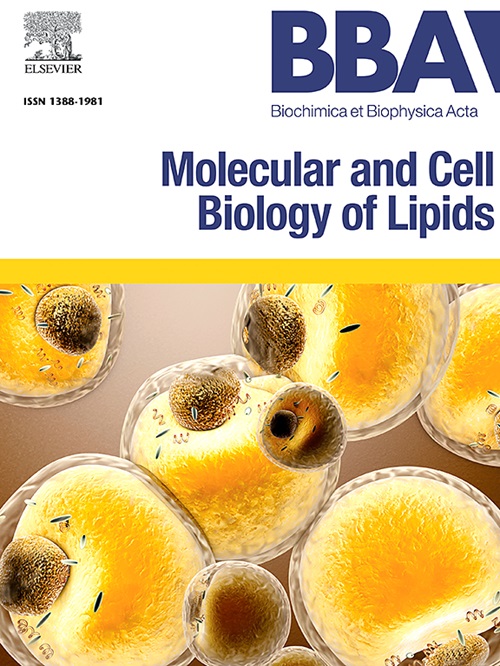在藻胞杆菌PCC 6803中,冷敏感途径将非天然的顺-7-十六烯酸延长为顺-9-十八烯酸
IF 3.3
2区 生物学
Q2 BIOCHEMISTRY & MOLECULAR BIOLOGY
Biochimica et biophysica acta. Molecular and cell biology of lipids
Pub Date : 2025-06-16
DOI:10.1016/j.bbalip.2025.159649
引用次数: 0
摘要
聚胞藻(synnechocystis sp. PCC 6803)的细胞膜主要由酯化的不饱和C18和饱和C16脂肪酸(FAs)组成。我们将牛链球菌的Ot17.2基因导入聚胞菌中。细胞Ot17.2+产生的顺式-7-十六烯酸(hypogeic acid, 16:1∆7)是C16 FAs总量的一半,表明Ot17.2基因编码叶绿体定位的C16特异性∆7去饱和酶。为了研究非天然不饱和C16 FA合成的影响,我们尝试降低c18特异性∆9去饱和酶desC基因的拷贝数,在Ot17.2+菌株中产生顺式-9-十八烯酸(油酸,18:1∆9)。令人惊讶的是,尽管已知desC基因对生存至关重要,但在Ot17.2+/desC-菌株中desC基因被完全删除。我们发现菌株的C18 FAs与野生型细胞一样是不饱和的。相比之下,对于C16特异性的∆9去饱和酶,我们不能在表达desC2基因的细胞中完全删除desC基因,产生顺式-9-十六烯酸(棕榈油酸,16:1∆9)。这些结果表明,聚囊藻可以通过FA伸长由16:1∆7合成18:1∆9,而由16:1∆9伸长产生的顺式-11-辛烷酸(异戊酸,18:1∆11)可能无法维持细胞生长。有趣的是,该菌株(Ot17.2+/desC-菌株)在低温下不生长,产生少量C18不饱和脂肪酸。在Ot17.2+/desC-培养液中添加18:1∆9或16:1∆7均支持生长,表明参与FA回收和延伸系统的脂肪酶活性可能对低温非常敏感。本文章由计算机程序翻译,如有差异,请以英文原文为准。
Cold-sensitive pathway elongates a non-native cis-7-hexadecenoic acid to cis-9-octadecenoic acid in the cyanobacterium Synechocystis sp. PCC 6803
Cellular membranes of the cyanobacterium Synechocystis sp. PCC 6803 primarily consist of glycerolipids esterified unsaturated C18 and saturated C16 fatty acids (FAs). We introduced the Ot17.2 gene from the Mamiellophyceae Ostreococcus tauri into Synechocystis. The cells, Ot17.2+, produced cis-7-hexadecenoic acid (hypogeic acid, 16:1∆7) at the half level of the total C16 FAs, suggesting that the Ot17.2 gene encodes chloroplast-localized C16-specific ∆7 desaturase. To study the effect of the synthesis of a non-native unsaturated C16 FA, we attempted to decrease the copy number of the desC gene for C18-specific ∆9 desaturase, producing cis-9-octadecenoic acid (oleic acid, 18:1∆9) in the Ot17.2+ strain. Surprisingly, the desC gene was entirely deleted in the Ot17.2+/desC- strain, despite the knowledge that the desC gene is essential for survival. We found that the C18 FAs in the strain were unsaturated as in the wild-type cells. In contrast, we could not delete the desC gene completely in the cells expressing the desC2 gene for the C16 specific ∆9 desaturase, producing cis-9-hexadecenoic acid (palmitoleic acid, 16:1∆9). These findings indicate that Synechocystis may synthesize 18:1∆9 from 16:1∆7 via FA elongation, and cis-11-octade cenoic acid (vaccenic acid, 18:1∆11) produced from the elongation of 16:1∆9 may not sustain the cell growth. Interestingly, this strain (Ot17.2+/desC- strain) did not grow and produced little C18 unsaturated FAs at low temperatures. The supply of either 18:1∆9 or 16:1∆7 into the culture of Ot17.2+/desC- supported the growth, suggesting that the lipase activity involved in the FA salvage and elongation system might be severely sensitive to low temperatures.
求助全文
通过发布文献求助,成功后即可免费获取论文全文。
去求助
来源期刊
CiteScore
11.00
自引率
2.10%
发文量
109
审稿时长
53 days
期刊介绍:
BBA Molecular and Cell Biology of Lipids publishes papers on original research dealing with novel aspects of molecular genetics related to the lipidome, the biosynthesis of lipids, the role of lipids in cells and whole organisms, the regulation of lipid metabolism and function, and lipidomics in all organisms. Manuscripts should significantly advance the understanding of the molecular mechanisms underlying biological processes in which lipids are involved. Papers detailing novel methodology must report significant biochemical, molecular, or functional insight in the area of lipids.

 求助内容:
求助内容: 应助结果提醒方式:
应助结果提醒方式:


